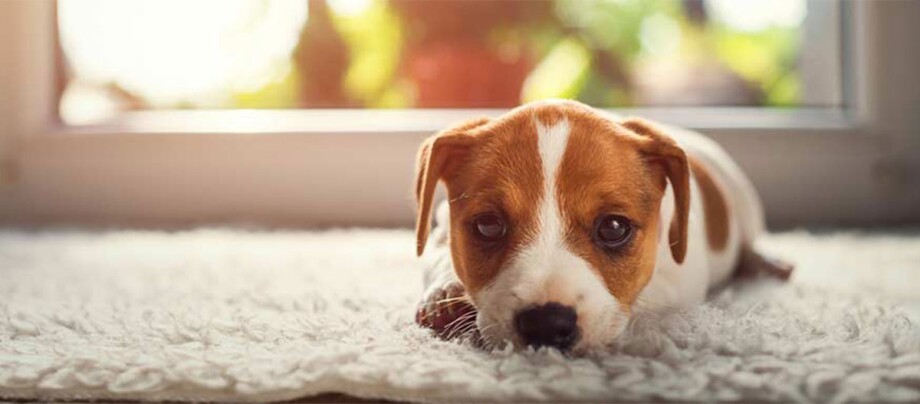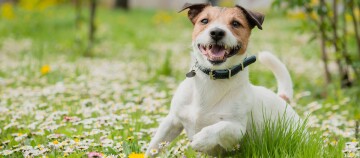Puppy First Day at Home - Make Your First Day as Stress Free as Possible
03.01.2023 - Reading time: 8 minutes

Want to get a dog? Which breed is the best fit for you? Or maybe you have already decided. Now it's time to get ready. We have put together some important information and tips on how to make your first days with a dog as stress-free as possible.
- Which dog will it be?
- Where do I buy a dog?
- Organisational matters regarding the dog
- A puppy is moving in: what to consider in advance
- The first car ride with your new family member
- A puppy moves in: the first day
- Safety, training and bonding
- Regular walking and rest periods
- A puppy moves in - as a second dog
- A puppy moves in: summary
Which dog will it be?
If you're just starting out, here’s some food for thought:
- What is my/our daily routine like? What exercise needs can we meet for the dog?
- What do we most like in a dog? Should it be alert, sociable or above all cuddly?
- Which activities should your four-legged friend be involved in?
- What “hair load” can we live with? How much care do we want to invest in our dog?
- Does the dog need to get along with children, cats or horses, for example?
Please avoid getting a dog breed that “everyone has” or someone else is raving about. A passionate jogger with a house and garden may love their husky, but this could quickly become frustrating for you as a city dweller in a small home and a gym subscription – and even more so for the dog! Online breed finders can help with choosing. Breed portraits, of which there are many, also give an initial insight – even though every dog is an individual.
Where do I buy a dog?
Once you have chosen a breed or type of dog (there are great mixed breeds!), you need to research where best to get it from. Responsible breeders and official shelters might be your first port of call. Of course, you can also get a dog from private individuals or from foster homes of animal welfare organisations. Recommendations are often helpful. You can also ask your local veterinary practice for good contacts.
Important: avoid purchasing from the boot of someone’s car on a motorway and other dubious business practices! The puppy is unfortunately likely to be unhealthy or already psychologically traumatised.
It should always be possible for you to visit the puppy in advance and more than once. How does it live, can you see its mother and litter mates? It should be vaccinated, chipped and wormed before coming to live with you. And it must not be separated from its mother and siblings too early. Otherwise there is a risk of a lack of social skills.
All this comes at a price: if puppies are being sold for very little money, this should at least make you wonder why!
Organisational matters regarding the dog
Finally, you’ve found your dream dog and you know when you want to bring it home.
Here is a small checklist of what you need to take care of in advance:
- Dog collar or harness?
- What do you want to feed your dog? Dry or wet food?
- When does the dog have to be registered for tax purposes?
- Regulations of the local administration on keeping dogs (lead requirement, etc.)
- Take out dog owner liability insurance.
- Find a vet.
- Is there a puppy school nearby?
- Who will look after your dog in the event of illness?
Talking to other dog owners as well as personal preferences (e.g. on the choice of puppy school) can help you make a decision. For health issues, the vet is always a suitable contact, who will also be happy to advise you on feeding.
A puppy is moving in: what to consider in advance
Even before it moves in, you should make the home puppy-proof: protect the curious newcomer from electric cables, poisonous plants and steep stairs. Also take the precaution of putting expensive rugs in a safe place.
The young dog does not yet know what it is and what it is not allowed to do, so put all objects of the puppy that could endanger it during its exploratory tours through its new home or that are dear to you out of reach. The lower the risk to the dog and the household contents, the more relaxed you can be when taking care of your precious one.
Decide where the fixed feeding place is going to be and where dog cushions or blankets can be placed. Is it allowed on the sofa? In the bed? This should be decided before the little rascal moves in, then followed consistently.
Especially for the first few nights, the puppy will miss its cuddly pack. It is good for it if the dog bed is close to you, where it can feel your presence. Your stroking hand provides security and safety. In addition, you can react quickly if the puppy’s bladder is full.
The first car ride with your new family member
If you pick up your puppy from a responsible breeder or shelter, it may have already be familiar with a car. But this is not the norm. So be prepared that it may find driving quite exciting!
The best thing to do is to get a transport box in which you put a blanket from the breeder or something else with familiar scents. Don’t respond to every whimper, but try to keep contact with the animal to reassure it. Water should be on board for longer journeys. You should also have a roll of kitchen paper on hand in case the dog gets excited and has an accident or vomits.
The puppy moves in: the first day
When the new resident comes into your the home, give it plenty of time to explore its new surroundings. Give it the opportunity to withdraw. Keep other people who are not part of the family away from the dog for the first few days. Also tell your children not to pester the dog and call it all the time. This way it can arrive calmly and get used to the new environment.
Now explore the home with your puppy, but limit this to two or three rooms at first.
Let it run around and explore a little and offer it several small meals throughout the day. If it is so excited that it doesn’t want to eat, don’t panic. As a rule, this will end after a short time. It is helpful to feed it the food it knows from “home” at the start.
Some puppies are very tired after a short time from all the excitement. Carry your puppy to its designated bed and cuddle it until it falls asleep. Attention is very important in the first few days, as the puppy is suddenly without its mum and siblings. It’s best to take some time off to discover the world together with your little one.
Safety, training and bonding
Although you should show the dog a lot of patience and understanding, it is important that it learns from the beginning what it is allowed to do and not allowed to do. The best way to do this is to ignore unwanted behaviour or comment on it with a short “no” and reward good behaviour with praise and treats (in moderation!). Show it from the beginning that it is worthwhile fot it to to orient itself towards you. Be consistent, because this makes you predictable and trustworthy for the dog.
Get to know your new family member in peace and give it plenty of time to explore its new surroundings. Extensive playtime and of course lots of cuddles will help you to quickly establish a bond with your puppy.
Walking and resting times
The young dog needs to relieve itself around every two hours. This is usually after sleeping, after eating, after playing and also during the night. You should anticipate its timing and take it outside regularly before it is too late.
Also, keep a close eye on your young dog. You will quickly notice if it becomes restless and paces nervously. Then it’s time again: the puppy’s bladder is bursting. Then give it the chance to relieve itself as soon as possible. This will also help it to become house-trained more quickly and easily.
It is important to know that a puppy cannot control its sphincters independently until it is around four months old.
The baby dog needs exercise and wants to explore the environment, but also needs regular rest periods. As soon as you notice that it is getting tired, it’s time to go home. In the first few weeks, this will happen quickly.
In order for your puppy to grow into a healthy dog, it needs a lot of sleep – up to 22 hours a day. During this time, it processes what it has experienced and recharges its batteries for new adventures. Make sure that the young dog can take its required sleep breaks of half an hour to an hour several times a day.
A puppy moves in - as a second dog
If you already have a dog, many of these tips will already be familiar to you, but give your new family member the chance to surprise you! Every dog is unique.
For integration into the pack to work well, dogs should be brought together slowly. Start on neutral ground, e.g. outside in a field. Retreat possibilities in the living area are very important, as each dog needs its own sleeping and feeding place. Rank fights are normal in the beginning, but please supervise your four-legged friend well if things get too rough. It is also possible that your first dog will not be very enthusiastic and/or react territorially. If this does not resolve itself over time, seek assistance from a qualified dog trainer.
Be sure to give your first dog enough attention, even if the puppy is super cute. Find activities that are fun for both dogs, this will bond them together.
A puppy moves in: summary
With a little preparation, an eye on the puppy’s needs as well as love and patience, your four-legged friend’s move in will all go fine.


